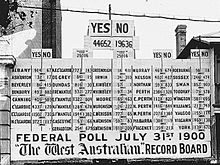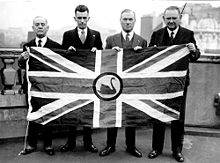- Secessionism in Western Australia
-
Secessionism has been a recurring feature of Western Australia's political landscape since shortly after European settlement in 1829. The idea of self governance or secession has often been discussed through local newspaper articles and editorials and on a number of occasions has surfaced as very public events including a State referendum in 1933. Organised groups have been established to agitate when the timing has been to their advantage.
Arguments in favour of secession are based on the assumption that a Federal government based in Canberra will favour the business and popular interests of the larger population centres. It has been said that Western Australia is a forgotten or Cinderella state, which contributes more to federal funds than it gets back, and is discriminated against by the more populous states.
In the modern economy, in per capita terms, Western Australia is the most productive state in terms of per capita income of $45,277 in 2003–04 compared with the national figure of $39,234.[1]
Contents
Colonial self-government
Petitions asking for representative elections for some of the positions in the Western Australian Legislative Council were presented to London in 1865 and 1869. This was granted in 1870 but maintained a Governor's veto.
In 1887 a new constitution including the right of self-governance was drafted and in 1890, the Act granting self-government was passed by the British House of Commons and assented to by Queen Victoria.
"Auralia" – goldfields separation movement
After several years of lobbying, in 1899 a well organised campaign in the goldfields presented a petition to Governor Lieutenant-Colonel Sir Gerard Smith entitled "Petition to Her Majesty the Queen from persons residing on the Eastern Goldfields, together with a refutation of the statements made in the petition, by Sir John Forrest" arguing the case for that region's separation from the Western Australian colony. [2] The Western Australian government led by Premier John Forrest were at the same time wavering in their support for the impending Federation due to a belief that they could hold out for a better deal for the state, while at the same time being lobbied by the other states' Federation committees for support to hold the federation referendum.
The other states' governments seized on the opportunity and the government was secretly threatened that its failure to support the Federation bill could mean approval being granted to the goldfields separatists. This, at least in part, encouraged the Western Australian government to move to join the Federation.[3]
Federation
In 1900, Western Australians voted in a referendum to consider the draft Australian Constitution of the proposed Federation of Australia.[4] The result of the vote was 44,800 in favour and 19,691 against. Most country electorates voted 'No', except Albany and the Goldfields, which voted 'Yes'.
The Constitution, which came into force on 1 January 1901 states in its opening preamble[5]:
“ WHEREAS the people of New South Wales, Victoria, South Australia, Queensland, and Tasmania, humbly relying on the blessing of Almighty God, have agreed to unite in one indissoluble Federal Commonwealth under the Crown of the United Kingdom of Great Britain and Ireland, and under the Constitution hereby established. And whereas it is expedient to provide for the admission into the Commonwealth of other Australasian Colonies and possessions of the Queen ... [emphasis added]
” Western Australia was not specifically mentioned in the preamble as its support was given too late for the document to be redrafted.
1933 referendum
See also: Western Australian secession referendum, 1933James MacCallum Smith, the proprietor of the local weekly newspaper, The Sunday Times started publishing pro-secessionist articles in 1907 under its editor Alfred Chandler. Smith was a committed secessionist and continued to agitate until the mid-1930s when a syndicate of mainly nationalists purchased the paper's parent company. In 1926, Smith and others established the Secession League to provide a public vehicle for advancing the secession cause.
Prior to the Great Depression in 1930, the State's major export had been wheat. However, with the depression, wheat prices plummeted and unemployment in Perth reached 30%, creating economic havoc.
Also in 1930, Keith Watson founded the Dominion League which advocated secession and the creation of a separate Dominion of Western Australia. The league held numerous rallies and public meetings which tapped into the general discontent brought on by the depression.
To counter the pro-secession movement, a Federal League of Western Australia was formed which organised a 'No' campaign. They brought several high profile people to Western Australia including the Prime Minister Joseph Lyons, Senator George Pearce, and former Prime Minister Billy Hughes for a brief speaking tour of Perth, Fremantle and country centres, but often received hostile receptions. The Federalists argued for a constitutional convention to examine the state's grievances but was unable to counter the grassroots campaign of the Dominion League. The question of holding a constitutional convention was the second question asked in the referendum.
On 8 April 1933, Nationalist Premier Sir James Mitchell's government held a referendum on secession alongside the State parliamentary election. The Nationalists had campaigned in favour of secession while the Labor party had campaigned against breaking from the Federation. 68% of the 237,198 voters voted in favour of secession, but at the same time the Nationalists were voted out of office. Only the mining areas, populated by keen Federalists, voted against the move.
The new Labor government of Philip Collier sent a delegation to London with the referendum result to petition the British government to effectively overturn the previous Act of Parliament which had allowed for the creation of the Australian Federation. The delegation included the Agent General, Sir Hal Colebatch, Matthew Lewis Moss, James MacCallum Smith, and Keith Watson. They argued as follows:
“ Our opponents lay great stress on the words contained in the preamble to the Commonwealth of Australia Constitution Act: - Have agreed to unite in one indissoluble Federal Commonwealth under the Crown of the United Kingdom of Great Britain and Ireland and under the Constitution hereby established.
They emphasise the word "indissoluble". We insist on the equal importance of the rest of the section: "Under the Crown" and "under this Constitution". Will it be contended that if – a highly improbable suggestion – the always loyal Commonwealth of Australia decided to break away from the British Crown and establish a republic, we in Western Australia should still be bound in the "indissoluble Federal Commonwealth?
Our contention is that the words "under the Constitution hereby established" are of equal significance, and if we can demonstrate – as we are prepared to do – that in a number of essentials, the Constitution has been violated to our detriment, we are entitled to be relieved from our bargain. The federation is a partnership between six States in which certain guarantees were given and certain safeguards were provided. We can show that these guarantees have been violated – that these safeguards have been swept aside – and so we ask for the annulment of the partnership.
After all, what does the word "indissoluble" mean? Remember that it occurs only in the preamble and not in the Act itself. Is any arrangement made in this world indissoluble? Can the rulers of any country 'dressed in a little brief authority', bind the people of that country not merely to the third and fourth generation, but for all time? Is there either justice or common sense in continuing an agreement that is working badly? Is a party to that agreement – after giving it a trial for 35 years and having proved it to be hampering to its industries, destructive to its prosperity and a grave bar to its development – prohibited from seeking relief? [6]
” The United Kingdom House of Commons established a select committee to consider the issue but after 18 months of negotiations and lobbying, it finally refused to consider the matter, further declaring that it could not legally grant secession. The delegation returned home empty-handed.
As a consequence of the failure of negotiations and of the economic revival, the Secession League gradually lost support and by 1938 had ceased to exist.
1974 Westralian Secession Movement
Iron ore magnate Lang Hancock founded the Westralian Secession Movement in 1974. His group focused largely on taxes and tariffs, arguing that trade barriers around Australia harmed the State's mainly mining and wheat export industries which earned a disproportionate amount of Australia’s foreign exchange. In the 1974 Senate election, the party fielded Don Thomas as an ultimately unsuccessful candidate.
The Western Australian economy was, however, in an upswing at the time with major capital works underway and prosperity at an all-time high. The movement stagnated after a few years.
Recent discussions
Western Australia's shares of various resources - 2010 data[7] % of Australian
totalPopulation 10.3% Gross domestic product 13.1% Mineral and energy output 48% Merchandise exports 39% Exploration 55% Private investment 28% Share of GST 8.1% At the 22 October 2008 Vista Public Lecture, former Western Australian Premier, Richard Court, indicated that the case for a secessionist movement is only strengthened while the Commonwealth government continues to exploit the State's resource-rich economy and fails to share the prosperity evenly.[8] He argued that Western Australia accounts for 35% of the nation's export income yet most of the revenue is used to strengthen the "financial muscle growing in Canberra". The state has approximately 9–10% of the nation's population, generates over 10% of the GST revenue, but receives only 6% of what is being distributed.[citation needed] Court highlighted that if the current Federation path continues, then by the year 2020, Western Australia will be receiving only 5% of what is being distributed by the Commonwealth Grants Commission. The former Premier said he was not advocating secession but stressed that the financial imbalance required addressing and that "the time to do so is now".
See also
Footnotes
- ^ "An Economic History of Western Australia since Colonial Settlement". Department of Treasury and Finance. 2004. http://www.dtf.wa.gov.au/cms/uploadedFiles/1593-econhistory-5a(1).pdf. Retrieved 2006-10-01.
- ^ ""Auralia"". Library and Information Service of Western Australia. http://www.liswa.wa.gov.au/federation/fed/028_gold.htm. Retrieved 2006-08-14.
- ^ "Separation movement on the Eastern Goldfields, 1894–1904". Journal and proceedings Western Australian Historical Society 1949, vol.4, part 5(1953): 41–58.
- ^ Musgrave, Thomas (2003). "The Western Australian Secessionist Movement". Macquarie Law Journal 3: 98. http://www.law.mq.edu.au/html/MqLJ/Volume3/Vol3_Musgrave.pdf. Retrieved 2009-10-12.
- ^ The Attorney-General's Department. "Preamble to the Australian Constitution". Archived from the original on 2006-05-10. http://web.archive.org/web/20060510074140/http://scaleplus.law.gov.au/html/pasteact/1/641/0/PA000040.htm. Retrieved 2006-04-21.
- ^ Library and Information Service of Western Australia. "Secession 1929–1939: London". http://www.liswa.wa.gov.au/federation/sec/065_lond.htm. Retrieved 2006-05-02.
- ^ "Resisting Canberra's centralist push". WA Business News: p. 36. 6 May, 2010.
- ^ Phillips, Yasmine. "Share the wealth or secession push will grow: Court". The West Australian 23 October 2008: 7.
References
- "1925 to 1950: From Federation to Thoughts on Secession". http://www.175anniversary.wa.gov.au/index.cfm?fuseaction=background.1925-1950. Retrieved 2006-04-20.
- "Western Australia and Federation". http://www.liswa.wa.gov.au/federation/sec/index.htm. Retrieved 2006-04-20.
Further reading
- http://www.liswa.wa.gov.au/federation/000_bibl.htm A collection of primary sources relating to secession at the J S Battye Library
- http://www.liswa.wa.gov.au/federation/iss/index.htm
- http://www.law.mq.edu.au/html/MqLJ/Volume3/Vol3_Musgrave.pdf
- http://www.fergco.com/~samgriffith/papers/html/volume3/v3chap5.htm – Geoffrey Bolton
- http://www.fergco.com/~samgriffith/papers/html/volume3/v3chap6.htm – Campbell Sharman
- http://www.curriculum.edu.au/ddunits/units/ms4fq3acts.htm#4act2
- Stateline – Norman Moore talks secession
Categories:- History of Western Australia
- Politics of Western Australia
- Secession in Australia
Wikimedia Foundation. 2010.







